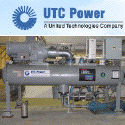Archive for April, 2007
UTC scores a big deal
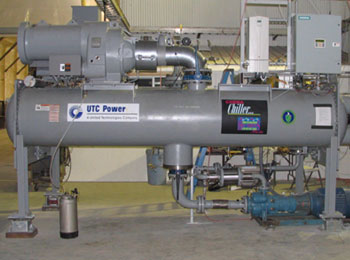
280kw (225kw net) PureCycle Unit
In what must be the largest deal yet for the UTC PureCycle binary power unit, Raser Technologies has placed an order for 135 units for use in its developing projects.
Effectively, UTC is using its experience in the industrial chiller field to run the chiller backwards using the geothermal resource as input. What distinguishes the UTC approach from others is two fold: operating temperature range 74C (165F) to 150C (300F) and modularity. The units are designed to work individually or to be ganged up in pods as large as 40 units with 9MW net output. It’s really a nice product and Raser shows good business sense by heading this direction. And, it’s a really nice endorsement of the UTC product and approach.
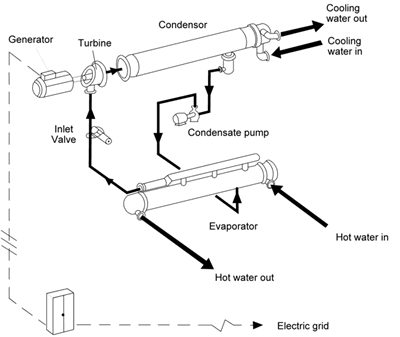
Illustration of how a binary unit works
As you can see from the diagram above, the binary unit is pretty straightforward. Hot fluid comes in, the heat is transferred to a working fluid through a heat exchanger, the working fluid vaporizes and drives a turbine, the working fluid is then cooled and returned to be reheated, the geothermal fluid is (typically) injected back into the reservoir.
Changing gears for the moment, this has had some business impact. Let’s look at what this impact has had on Raser’s stock.
Even though this constitutes movement for Raser, the reaction that is occurring in the stock is nothing less than irrational exuberance. The stock is up at the time of this writing over 30%, and that brings a one month run up of nearly 100% in the stock. While I appreciate that Raser is making very important strides in making their geothermal portfolio a reality, the valuation is wildly mismatched to the fundamentals.
Let’s do some math. Let’s assume that Raser can bring on all 30MW of power in 2008, possible, but it will be a push. Using generous assumptions of power sale at $0.07/kwh and a capacity factor of 95% that would yield around $17.5M in gross power sales per year. On the cost side, wheeling, transmission, and congestion costs will be around $0.015/kwh and plant operations costs will be in the $0.03/kwh range leading to a cost of $0.045/kwh. We haven’t factored in SG&A, depreciation, or debt, but my guess is that’s going to be in the $0.015-$0.025/kwh range. Yes, there will be the Production Tax Credit benefit of $0.02/kwh which will effectively make this tax free earnings, but, the net margin will be rather low, let’s say Raser pockets $2.5M/year on this set of assets. At standard power company valuation of 18.3 times net earnings, that would support a $45.75M market cap for this operation – at Ormat valuation (perhaps a closer comp) of 40x net earnings, that would support a $100M market cap.
This entry is not intended to slam Raser, I’m happy to see the company take these steps and roll out press releases every few days, but I think the valuation of the issue is wildly mismatched to reality. Raser sports a market cap of $464M at present (7:30am PDT April 12, 2007.)
Caveat emptor.
Update 4/16/2007: There have been some questions about whether or not this is an attempt to value Raser Technologies as a whole, it is not. The author has no detailed knowledge of the symetron technology that Raser has developed. The only information that the author has is that there is $400,000 of sales to date of the technology with opportunity for wider adoption. Rightly, that technology should not be valued at $0. However, in the author’s opinion, neither does that technology serve to bridge the valuation gap between the current market cap of $400M and the in operation geothermal plant valuation of $100M. So while we’re not attempting a detailed valuation, common sense dictates that a $400k revenue stream, however promising, does not justify $300M in market cap and thus the author sticks to the conclusion that Raser, at present prices, is overvalued. What is a fair value? That would require in-depth knowledge of the symetron technology to derive a valuation and then simple addition to the geothermal operations.
One other topic this initial post did not cover adequately was resource development cost. According to our research, geothermal resources cost between $1.2M on the low end of the range to $6.7M per megawatt. The average price for projects developed in the US over the past 10 years is $4.3M per megawatt. Drilling costs are the major variable in those figures running at around $1,300 per meter. The UTC unit cost (list price) alone is $1.4M per megawatt. Make no mistake, these are expensive projects to develop.
Finally, resource quality comes into play. The lower the temperature the lower the pressure is likely to be in the production wells. That implies pumping to get the resource to the surface for use in the generation units. This increases parasitic loads. The Stillwater plant in Nevada is a 19MW gross operation, but up to 50% of the output is dedicated to parasitic load. So when valuing the 30MW installation, it is likely overly optimistic until a resource review shows that the parasitic load will allow for that output.
There have also been some comments indicating that this source is anti-Raser. That’s simply not the case. Raser, like any other company in this space has a market valuation and an intrinsic valuation. When there is a difference between those two values, it’s interesting to explore. This has previously been pointed out with a Raser competitor, Ormat. Though the disparity between the two values is not so large in that case. The author would like to point out again, that Raser is making good public steps in development of its projects, management seems to be making shrewd choices, and that at the right valuation, Raser could be a good long term investment.
Disclosure: The author holds no shares in UTC or Raser Technologies
Mechanical Ocean Energy Conversion
Yesterday we explored Ocean Themal Energy Conversion and today we’ll move to mechanical harvest of the ocean’s energy. In the past, we’ve done an entry on tidal barrage which is one form of mechanical conversion using a reservoir system.
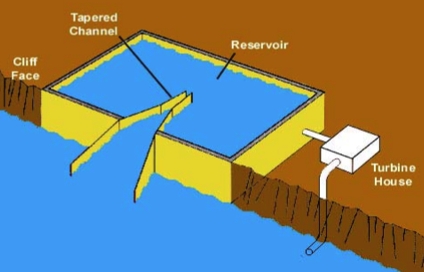
Illustration of channel reservoir system
Fundamentally there are two ways to mechanically harvest ocean energy, using the wave motion and/or using tidal action. One of the simplest devices is the channel reservoir system which uses tidal action and wave action to capture water in a reservoir then uses gravity to release the water through a turbine.
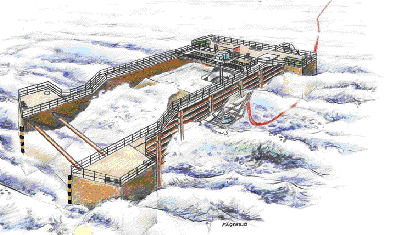
Example of floating reservoir system (Seapower)
Commercial interest in reservoir systems has existed for some time with Sweden’s Seapower, Norway’s Norwave, Denmark’s Waveplane International, and Wave Dragon. The animated gif below shows the Wave Dragon floating platform that is intended to capture water from the waves breaching the outer rim of the device, holding the water in a reservoir, then allowing it to drain through a turbine generating electricity.

We’ll look at other harvest technologies in future entries.
Raser gets more resource
Raser Technologies announced today that it has secured seven more geothermal leases in Utah, adding 13,887 acres to its portfolio. Investors seemed to like the news sending to stock up more than 3% on the news. However, investors should realize that development of geothermal resources take years; greenfield development is slow and fraught with difficulty. Nevertheless, it is encouraging to see a company approach the challenge with obvious passion and enthusiasm.
Comments are off for this post
Thermal energy harvest
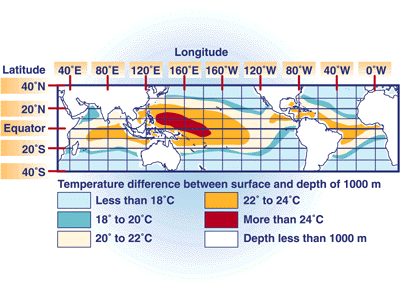
There are principally two ways to harvest energy from the ocean, mechanically (think waves and tides) and thermally (think solar energy stored in the water and temperature difference between deep ocean and the surface.) Ocean Energy Thermal Conversion (OETC) has been around well over 100 years and works either in an open or closed cycle (works just like organic rankine cycle geothermal systems.) The prospects of OETC were first proposed in 1881 by Jacques Arsene d’Arsonval, a French physicist.
The concept was first proved in 1930 by Georges Claude off the coast of Cuba with a 22 kilowatt unit and later off the coast of Brazil with a 10,000 ton cargo vessel. Both plants were destroyed in storms before either had demonstrated net power production (producing more energy than the system consumes during operation.) In 1956 the French made another attempt at OETC off the Ivory Coast planning a 3MW facility. While construction was started, it was never completed due to high costs.
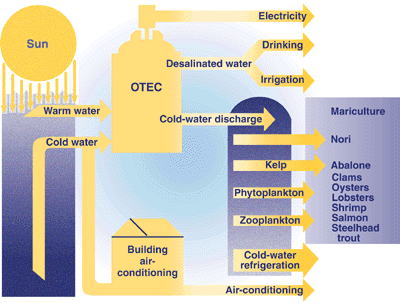
Illustration of an Ocean Thermal Energy Conversion plant
The first oil crisis spurred the US into the act in 1974 when the Natural Energy Laboratory of Hawaii Authority was established. The group created a 52 kilowatt mini-OETC plant that was moored a couple of miles off the coast that was a net producer (15 kilowatts,) enough to operate the ship’s electrical systems. In 1999, the group successfully tested a 250 kilowatt system. Both of these experiments were closed or binary approaches.
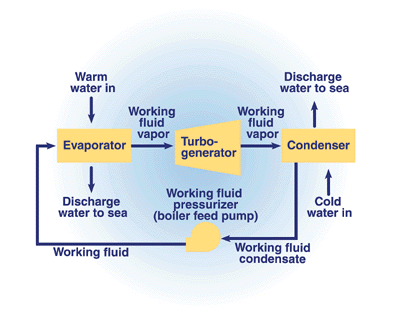
OTEC Closed Cycle Plant Illustration
In 1984, NELHA created a 50 kilowatt open system, boiling seawater at low pressures, that had efficiencies as high as 97%. It turns out the open approach also has the interesting by-products of nearly pure fresh water, very cold sea water, and the solids left by evaporation which can be rich in up to 57 different trace minerals. This could have a use in desalination, mining, and aquaculture in addition to simply producing power.

OTEC Open Cycle Plant Illustration
The National Renewable Energy Lab has ceased all work in this area, this isn’t uncommon in today’s DoE as they seem to only care about nuclear power and the elusive “clean coal” technology. But, private firms are continuing to explore this concept and seem to be moving ahead slowly. NELHA remains the only site with active use of OETC, though it is relatively small scale and used principally for aquaculture.
Commercial development is still underway with proposals for 100MW sea power plants by Sea Solar Power Inc. and SEA02’s proposal for an ocean-based, sustainable city called Townsville.
Ocean energy harvest
This week we’ll tour the advances happening in ocean energy. Why? Check the map out below for one reason:
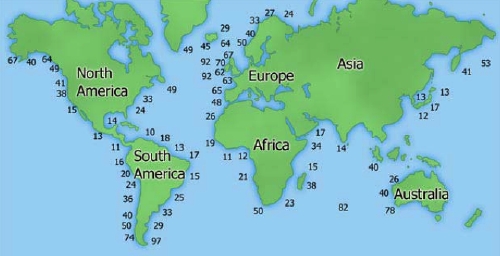
The figures above indicate potential power available in kilowatts per meter. As is clear from the map, there is an enormous amount of energy in the ocean simply waiting to be harvested. Given that the Earth’s surface is 70% covered in ocean, this is a vast untapped energy resource. In future entries, we’ll delve into the major harvest technologies, both mechanical and thermal, and we’ll take a look at the companies attempting to make a commericial success in this area.
Stay tuned for more information.



